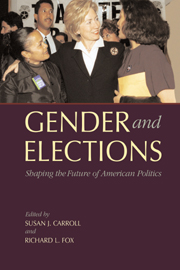Book contents
- Frontmatter
- Contents
- List of Figures, Text Boxes, and Photo
- List of Tables
- Acknowledgments
- List of Contributors
- Introduction: Gender and Electoral Politics into the Twenty-First Century
- 1 Presidential Elections
- 2 Voter Participation and Turnout
- 3 Voting Choices
- 4 Congressional Elections
- 5 African American Women and Electoral Politics
- 6 Political Parties and Women's Organizations
- 7 Advertising, Web Sites, and Media Coverage
- 8 State Elections
- Index
8 - State Elections
Where Do Women Run? Where Do Women Win?
Published online by Cambridge University Press: 05 June 2012
- Frontmatter
- Contents
- List of Figures, Text Boxes, and Photo
- List of Tables
- Acknowledgments
- List of Contributors
- Introduction: Gender and Electoral Politics into the Twenty-First Century
- 1 Presidential Elections
- 2 Voter Participation and Turnout
- 3 Voting Choices
- 4 Congressional Elections
- 5 African American Women and Electoral Politics
- 6 Political Parties and Women's Organizations
- 7 Advertising, Web Sites, and Media Coverage
- 8 State Elections
- Index
Summary
Voters in Washington state are used to seeing women's names on the ballot. Not only is Washington represented in the U.S. Senate by two women, but one-third of the state legislature is female.
Elsewhere, voters face a different political environment. South Carolina is a good example. Not only do several thousand miles separate Washington from South Carolina, but the two states are worlds apart in terms of gender and politics. In South Carolina, fewer than 10 percent of state legislators are women, and voters there are much less familiar with women candidates.
The presence of women in statewide office varies across the country as well. For example, Arizona has set a number of records for women in state politics, including being the only state in the nation where a woman governor has succeeded another woman. Arizona is not typical, however. In a recent study, women held more than one-third of all statewide executive offices in some states but no statewide offices in other states.
This state diversity in women and politics makes for interesting trivia. But does it matter that the presence of women officeholders varies so widely? Investigating the progress of women in the states is worthwhile for several reasons. If more women are to win seats in Congress, more women need to seek office in the states. State legislative and executive offices are rungs on the career ladder typically climbed by ambitious politicians – stepping stones to higher office including the Oval Office.
- Type
- Chapter
- Information
- Gender and ElectionsShaping the Future of American Politics, pp. 189 - 214Publisher: Cambridge University PressPrint publication year: 2005
- 2
- Cited by



